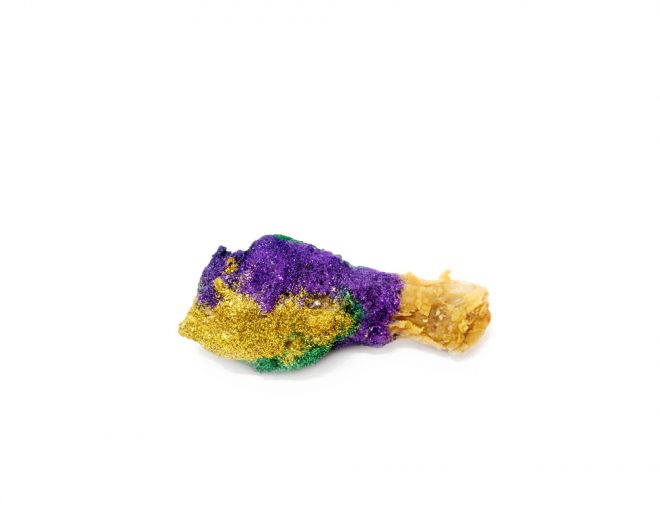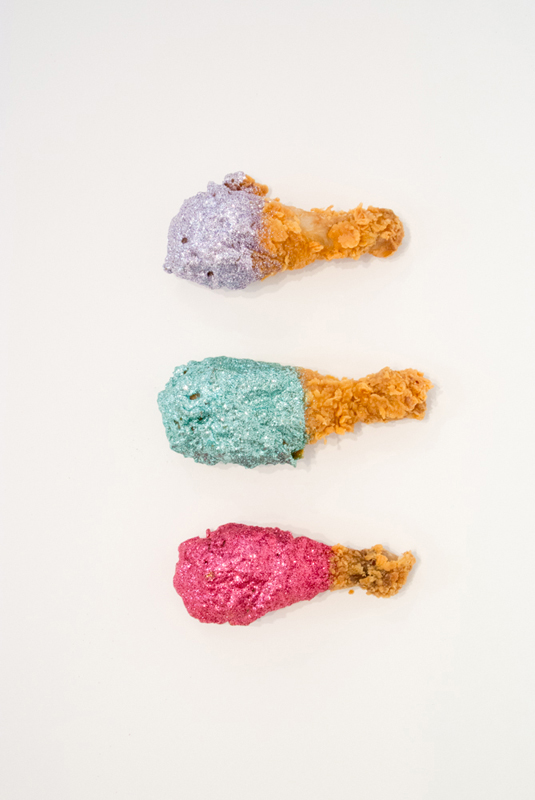Fresh Out the Frying Pan: An Interview with Artemis Antippas
Rosemary Reyes talks with local emerging artist Artemis Antippas.

New photograph by Artemis Antippas available exclusively from Pelican Bomb's Community Supported Art.
Editor's Note
Artemis Antippas made her exhibition debut this August at the Ogden Museum of Southern Art’s annual “Louisiana Contemporary,” where she was awarded an honorable mention. Her Chicken photo series caught our attention and we’re excited to team up with Antippas to offer two new photographs exclusively for Pelican Bomb's re-launched Community Supported Art (THE DROP for all you old timers).
Rosemary Reyes sat down with the native New Orleanian to talk family, food, and how growing up in the city influences her life and work.
Rosemary Reyes: I originally wanted to conduct this interview over fried chicken but nixed the idea. I feared the deliciousness would get in the way of productive conversation.
Let's start by talking about what brought you to display your work publicly this summer?
Artemis Antippas: I’ve been making work for a while now. I moved back to New Orleans a few years ago and being home with my mom [the painter Anastasia Pelias] in her studio watching her work everyday really encouraged me to start putting it out there. I was lucky to get my photographs into the “Louisiana Contemporary” show at the Ogden and that was an encouraging moment for me. I got a few write-ups and felt really supported by the community afterwards, so it was a big positive push for me to keep going.
RR: When I first saw your chicken photographs, I immediately smiled. That was my initial reaction. What emotions are you hoping to elicit from your audience with the work?
AA: Well, I love that it made you smile. I think the pieces can be a bit shocking and it can take a while to understand that it is fried chicken, but it is really a very personal series for me. Moving back to New Orleans a few years ago, I didn’t feel 100 percent sure that this is where I needed to be. So, at first I fought being here and the idea of being back home. It felt like I was giving up on the rest of the world.
The series helped me be okay with being back and embrace everything that is New Orleans. For me, the chicken represents so much of the city and what the city is about—the celebrations and the festivals and everything. I mean, there’s a festival every weekend here. It’s crazy. The series was about falling back in love with my hometown.
Visually the city is everything for me. I don’t even have to leave my house, but walking through the French Quarter, where I grew up, I can still spend an afternoon walking around and get excited. Every crack in the sidewalk, every character sitting on the corner is a huge part of the way that I work.
RR: As you mentioned, it’s a city that truly values celebration, creativity, and also the power of dressing up. Would you say the gilded fried chicken legs are in costume? Is that something you had in mind when you decided to dress the chicken in glitter?
AA: No. That’s a beautiful way to look at it though. I never considered the glitter to be a masking of the chicken, but I love that.
RR: The photographs also project the extremes of the city. Fried chicken isn’t pretty-looking, all craggy and anemic. It’s off-putting, especially when photographed in this stark and revealing way. The glitter, on the other hand, is so dreamy, colorful, and pleasing to look at. It’s pure fantasy. I wanted to expand on that and discuss how the work speaks to the dichotomies of New Orleans.
AA: New Orleans is constantly referred to as a checkerboard. You’ll have one beautiful block with gorgeous homes and well-cared-for gardens. The block down the street might be blighted and ignored. That is the reality of New Orleans. The chicken is totally grotesque if you actually look at it, but throw some glitter on it and it’s transformed.
I think it can reflect the city as a whole, especially considering the role it plays on people’s tables. I know you’re new here, but you’ll soon catch on that no matter what party you go to—whether it’s a gala at a mansion with champagne or someone celebrating on their front porch with store-bought birthday cake and a bouncy house—you can find fried chicken. It may be from Galatoire’s or Popeyes, but fried chicken is fried chicken. I think that says it all. It’s a unique city.

RR: You got your supply of chicken for the project from Popeyes. As you became a regular at Popeyes, which is a locally founded chain, what kinds of exchanges did you have with other New Orleanians?
AA: I have developed some special relationships there, specifically with the manager at the Popeyes on Claiborne. She still doesn’t understand what it is I’m doing with the chicken and it’s difficult to describe. I need to bring in some photographs to show them. Every time I go it’s a 20-minute wait because I only want legs. They always have to make a fresh batch, which I know annoys them, but they’re patient with me. So, I get to sit and observe the customers and the employees. That has become an important part of the process.
RR: Any narratives that stand out to you?
AA: Last week I overheard this woman who was eating the five-dollar box that everyone orders. It’s a new product that’s very popular. The woman’s name was Angel and she was with a few people eating when she got a phone call. She had her phone on speaker and I could hear the person on the other end: “Hi, I’m from Florida. I saw that you were on our website and that you’re interested in losing weight.” It was a call from one of those scammy weight-loss clinics, but there was Angel, eating this five-dollar box, having a conversation about how she wants to lose weight and the steps to do that. I listened to the whole thing, and it may sound silly, but it was this brief window into her life—something she’s struggling with.
RR: Trying to accommodate lifestyle with tradition…
AA: It’s not easy!
RR: Pelican Bomb has commissioned you to make work for the Community Supported Art program. Can you talk about what you’re doing for that program and your use of color?
AA: I made two photographs. One uses red, white, and blue glitter. The other uses purple, green, and gold glitter. For me, those sets of colors signify everything that is New Orleans. I know you haven’t had a Mardi Gras here yet, but you’ll get it right when it comes around.
Since I started working with the chicken I have wanted to explore the use of multiple colors on one chicken leg. It just felt right making the first red, white, and blue—good old American pride—then bringing in the New Orleans pride of Mardi Gras was natural.
RR: It returns us to that question of extremes. In my limited experience, New Orleans strikes me as a place where all of the best and worst things about the United States are visible and on the surface. It is at the same time the most and least American city in America.
Let’s talk about the heavy importance of food in New Orleans—how food maintains not only a literal vitality, but a spiritual and emotional connection as well. What’s your relationship with food?
AA: To say that I’m not interested in food is strange, but I didn’t grow up in a household where we ate out a lot. My mother is a really good cook and she can make something delicious out of nothing. Going out to restaurants is not very appealing to me. I would rather eat in the comfort of my own home. It’s funny because when I do go out all I talk about is what I ate for brunch or what I’m going to eat for dinner the next night.
RR: In your approach to photographing the chicken, did you consider them as food objects?
AA: I consider the photographs to be portraits, so that’s how I approached them.
RR: Your work is also included in Pelican Bomb’s “Foodways” exhibition.
AA: For the exhibition, I wanted to experiment beyond photography. I initially pitched a sculpture using real fried chicken but that was axed pretty quickly for sanitation concerns—bug problems or it rotting and smelling terrible. So, I accidentally entered the bizarre world of fake foods, which has led me to interesting conversations with people all over the country. I’ve opted to use fake chicken that to me looks very realistic. The fake chicken is dipped in glitter and is sitting on a proper shiny platter that’s on this rotating turntable. It’s a ridiculous piece, but that’s what I’m trying to get at and see how people react.
RR: It also speaks to temptation—these decadent objects sitting on a silver platter just waiting to be grabbed.
AA: Yes, absolutely, temptation and indulgence, but hopefully nobody grabs at it!



